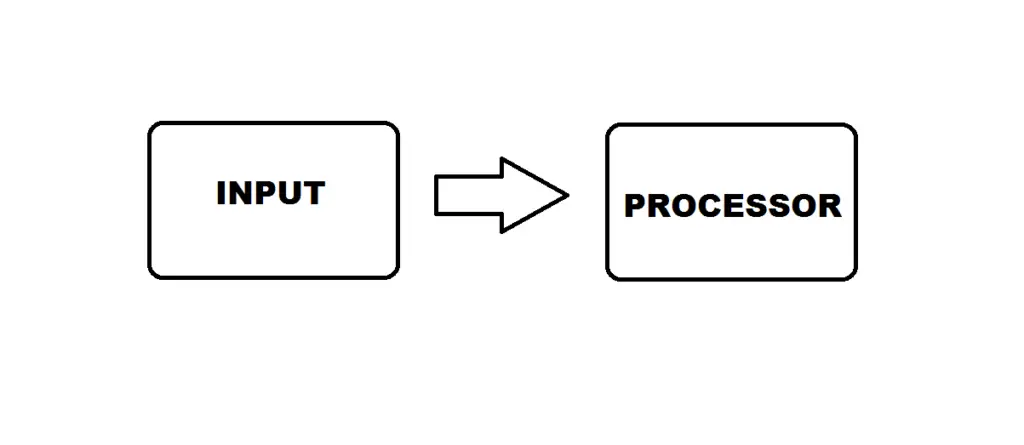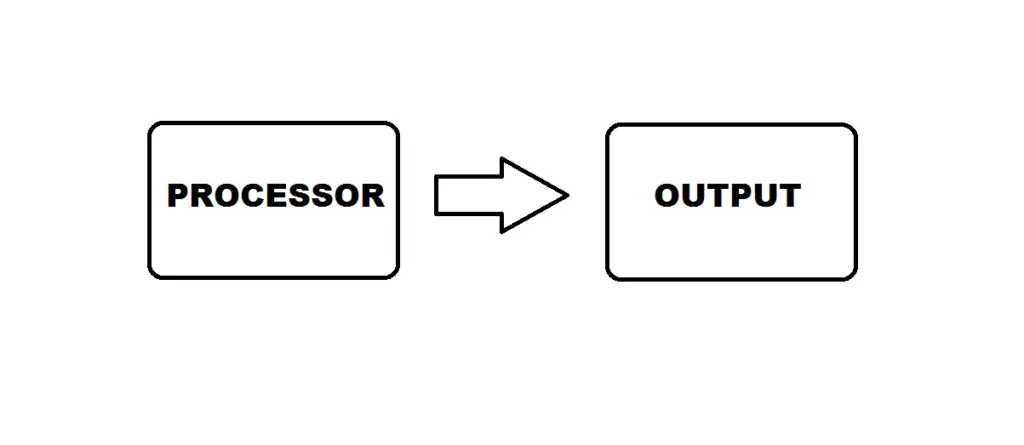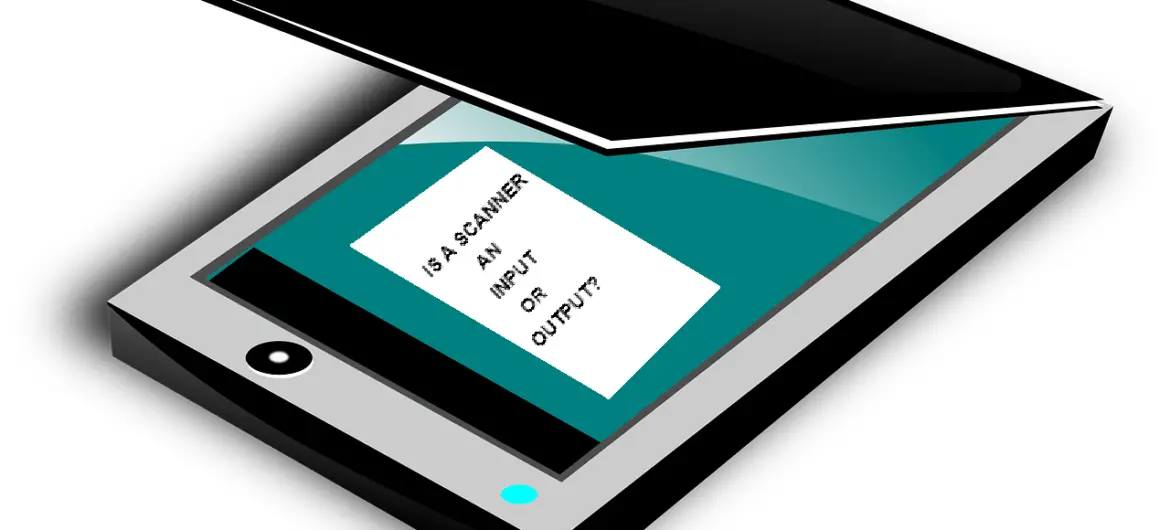Fax machines used to be the way for sending documents to someone (collegegue, friend, family, etc) when they were in another location.
But, E-Mail is now the preferred way of sending attachments such as documents, images, etc.
Sometimes however, you might need to send a digital copy of a physical document or image.
This is where a Scanner has lent its helping hand.
A scanner enables you to make copies of documents, images, etc, which then get sent to the computer as a digital file.
But, is a scanner an input or output device?
A scanner is an input device. The scanner ‘scans’ images, converts it to digital data and then sends it to a computer. The main reason that a scanner is an input device is that the flow of information works its way from the outside world ‘inward’ towards the computer.
I shall explain in more detail in this article why a scanner is an input device.
What is input and output device
To better understand why a scanner is an input device, it will help to understand both Inputs and Outputs and see what the main differences between them are.
Input devices
An electronic system will usually include a processor at the center of its operation.
This processor can be a *Microcontroller or a Microprocessor* depending on the needs, and complexity of the application.
It is responsible for ‘processing’ information.
In this case, the processor is onboard the computer’s motherboard, which is essentially the brain of the computing system.
This information can be generated internally by the processor itself, or the information can be received via Inputs.
The reason for being called an input is because information, or power is entering the system. This can be best visualised by the diagram below.

An input device’s main job is reacting to changes in the environment or physical responses by a user which could be as simple as a button press.
The processor can then deal with the information as required.
A note to be made is that embedded systems are usually where you would find a Microcontroller or Microprocessor being used as the processing unit.
However, an input can also be part of a non-embedded system, which can be void of a microcontroller or microprocessor.
For example, a flashlight is a simple circuit that does not include a processing unit but includes an input like a button.

There are many different types of input devices available that provide different functionalities in different circuit setups.
Below is a list of some of the many;
- Buttons
- Mouse
- Keyboard
- Switches
- Sensors
- Temperature
- Humidity
- Light
- Colour
- Microphones
- Potentiometers
- Light Dependent Resistors (LDR’s)
Below are some common applications that use these input devices;
- Computing (Mouse, Keyboard, Webcam etc)
- Mobile phones (Keypad, Capacitive touch screen)
- Automobile (buttons)
- Entertainment systems (buttons, switches, potentiometers)
- Weather stations (Temperature and Humidity sensors)
Output devices
So, we have seen one half of an electronic system,where information enters it through means of power and information via physical changes in the environment also known as the Input.
The second half of the system is an Output.
An output can be best described as information or power leaving the system which can be visualised by the diagram below.

Once the information has been processed by the processor, it can then be sent out of the system into the real world via an output device.
An example would be displaying information on an Liquid Crystal Display (LCD).
Just like an input, outputs can be part of non-embedded systems as well.
Going back to the flashlight example, when the button (input) is pressed by the user, a light turns on. The light here is the output of this simple electronic system.
Below is a list of common outputs;
- Motors
- Servo
- Stepper
- Vibration
- Buzzers
- Speakers
- Displays
- Lighting
- Light Emitting Diodes
- Light Bulbs
- Electroluminescent wire
- Printers
Below are some common applications that use these output devices;
- Audio systems (Speakers)
- Entertainment (Displays)
- Computing (Printers)
- Interior decorating (LED, Light bulbs)
- Mobile phone (Vibration Motors)
Why a scanner is an input device and not an output
So, now we know the roles of an input as well an output device, we can dive into why a scanner is an input device and not an output.
As we saw in the flow diagram of input devices, information is sent from the input to the processor.
The scanner is a device that captures information and sends it to the processor (in this instance a computer).
It scans an image, then converts it into digital data which is then sent to a computer for processing.
The flow of information starts from outside of the processing unit, and makes its way toward the computer as we saw earlier with the flow diagram of input devices.
How a scanner works as an input device
Let’s take a closer look at how the scanner is able to send information to a computer as an input device.
There are many different types of scanners available.
The one you are probably most familiar with is a desktop scanner known as a Flatbed scanner. This type of scanner is synonymous with desktop computers.
Other variety of scanners include;
- Sheet-Fed
- Hand-Held
- Drum
While there are a variety of scanners, the working principle and purpose for each of them remains the same; which is to analyse an image/document and process it in some way.
If we were to open up the sanner you would find the following parts;
- Charge-coupled device (CCD) array
- Mirrors
- Scan head
- Glass plate
- Lamp
- Lens
- Stepper motor
- Belt
- Control circuitry
The main part of the scanner is the CCD array which is consistent across the different types of scanner.
The CCD array consists of a number of tiny light sensitive diodes which convert photons (light) into electrons (electrical charge).
To not go into too much detail, below is a summarized version of what is involved when a document is scanned;
- Document/Image placed on glass plate
- Lamp illuminates document
- Scan head (mirrors, lens, filter and CCD array) moved slowly across length of document with belt which is attached to stepper motor
- Image of document reflected by a mirror that is angled to a second mirror (each mirror is curved to to focus image onto a smaller surface)
- The last mirror reflects the image onto the lens which then focuses the image through a filter onto the CCD array.
How does a scanner get connected as an input to a computer
Connecting a scanner to a computer as an input is very simple. It only requires one wire to do so.
The type of wire it uses is a Universal Serial Bus (USB) cable.
USB is a type protocol for connection, communication and power supply, which is specified for cables and connectors.
These cables are used for computers, peripherals and other other computers.
So, the scanner can get connected to a computer and communicate with it while also being powered, with one cable!
However, newer scanners do not require a USB cable as they are designed and have the capability to connect with a computer using Wi-Fi.
This can be advantageous as the scanner does not have to be placed near the computer.
Where can a scanner be used as an input device?
A scanner is commonly used as an input device to a computer or a laptop.
But, with the ability of new scanners to communicate with host devices using wi-fi, scanners can now be used as an input device with many other wi-fi capable devices such as Smartphones and Tablets.
What are other input devices similar to a scanner
A scanner is only one of the many input devices that sends data to a computer.
There are many other input devices that provide different types of data to computers through means of audio, video, and motion
Below are some of the most common inputs used in conjunction with a computer;
- Webcam
- Mouse
- Keyboard
- Digital camera
- Microphone
- Joystick
What is the purpose of scanner as an input device in a computer
The main purpose of a scanner is to create a digital version of a physical document or image that you have.
This feature of the scanner opens up doors to many applications which make it a necessary peripheral when using a computer.
Long distance communication- As mentioned at the start of this article, fax machines were the standard tool used if you needed to send a document from one place to another. This was how business was done for a long time.
But, with the emergence of scanners, along with email, the process of sending documents and images was made much easier.
You could scan multiple documents and images and send them via email to your intended recipient.
Preserving memories – Digital cameras are standard for capturing your memories these days. They can save your photos onto an SD card which you can save onto the cloud so they are safe.
But, before digital cameras were available, cameras had film which then had to be developed into physical photos.
Physical photos degrade over time, and you also run the risk of losing them or damaging them.
If you have photos from your past, you can convert them to a digital image and store them on your computer or the cloud which is a much safer option.
Drawing – There are great software programs that allow you to modify and create beautiful digital artwork.
The two most commonly used programs are Adobe Photoshop and Illustrator.
Nowadays as an artist, you can take your initial sketches on paper, scan them onto a computer and modify them using the software programs mentioned above.
This wouldn’t be possible without a scanner.
Who can use a scanner as an input device?
The scanner is not restricted to a certain type of person or industry.
It is beneficial for personal and business use.
It can be used by anyone who needs to make digital copies of existing documents. It all comes down to your needs and applications.
Can a scanner be used as an output device?
No, a scanner cannot be used as an output device.
The computer does not send information to or control the scanner in any way, but rather receives information from it.
That’s why it cannot be used as an output device.





